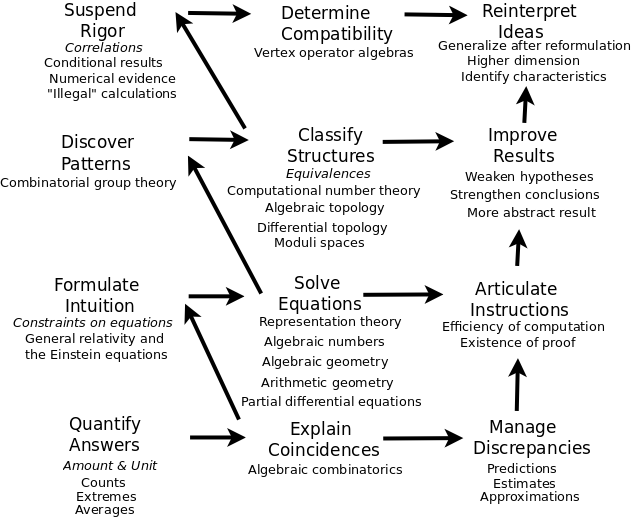- MathNotebook
- MathConcepts
- StudyMath
- Geometry
- Logic
- Bott periodicity
- CategoryTheory
- FieldWithOneElement
- MathDiscovery
- Math Connections
Epistemology
- m a t h 4 w i s d o m - g m a i l
- +370 607 27 665
- My work is in the Public Domain for all to share freely.
- 读物 书 影片 维基百科
Introduction E9F5FC
Questions FFFFC0
Software
Organize the branches of mathematics in term of the kinds of answers that we seek in math.
Math Answers = Branches of Math

Note:
- S = The subject is defined by the kind of answer sought.
- E = The subject exemplifies the kind of answer sought.
Mathematical answers
Quantify answers
- Exact counting (Listing) S= Enumerative combinatorics (polynomial time algorithms for computation)
- Extremal problems S= Extremal Combinatorics
- Averages S= Probabilistic combinatorics
Explain coincidences
- S= Algebraic combinatorics (interpreting formulas)
Manage discrepancies
- Estimates S= Analytic number theory
- Approximations S= Numerical analysis (algorithms for approximating the continuum)
- Predictions S= Stochastic processes (model the evolution of random phenomena)
Formulate intuition as constraints on equations
- E= General relativity and the Einstein equations (expressing, interpreting and validating a theory of physics)
Solve equations. Any solutions? Unique solution? Constraints on solutions?
- Linear equations. S= Representation Theory
- Polynomial equations. S= Algebraic numbers
- Polynomial equations in several variables. S= Algebraic geometry
- Diophantine equations. S= Arithmetic geometry
- Differential equations. S= Partial differential equations
Articulate instructions. Find explicit proofs and algorithms
- S= Computational complexity (what can be computed efficiently or not)
- S= Logic and model theory (formal languages about mathematical structures, whether a proof exists or not)
Discover patterns
- S= Groups (symmetries), Combinatorial group theory (groups in terms of their generators and relations)
Classify structures.
- Building blocks and combinations. E= Computational number theory (identifying primes as components or in totality)
- Families and exceptions. E= Algebraic topology
- Transformation demonstrates equivalence. E= Differential topology (classifying smooth manifolds - list all smooth structures on any topological manifold and be able to identify them - a certain set of discrete subgroups of the isometry group of any one of the eight model spaces determines a compact manifold with the corresponding geometric structure)
- Invariant demonstrates nonequivalence. E= Algebraic topology
- Map to a structure E= Moduli spaces (give a geometric structure to the totality of the objects we are trying to classify)
Improve results
- Weaken hypotheses. E= Operator algebras (expanding from finite-dimensional equations to integral equations)
- Strengthen conclusions. E= Harmonic analysis (determining the properties of functions that are not explicitly describable, for example, the effect of operators on the boundedness of functions)
- Prove a more abstract result. E= Category theory
Suspend rigor. Work with arguments that are not fully rigorous.
- E=Conditional results = Dynamics (how systems evolve in time)
- E=Numerical evidence. = Probabilistic models of critical phenomena (modeling thresholds for divergent outcomes)
- E="Illegal" calculations. = Mirror symmetry (reformulating a physical theory's information in a mirror theory)
Determine compatibility. Whether different mathematical properties are compatible.
- E= Vertex operator algebras (formulating perspective: relating quantum data and space-time manifold)
Reintrepret ideas.
- Identify characteristic properties. E= Geometric group theory (groups in terms of their actions expressed geometrically)
- Generalize after reformulation P= Set theory (distinguishing between cardinals-sets and ordinals-lists and relating the two)
- Higher dimensions and several variables. E= High-dimensional geometry and its probabilistic analogues (most efficient boundary for volume, the sphere, models random distributions)
